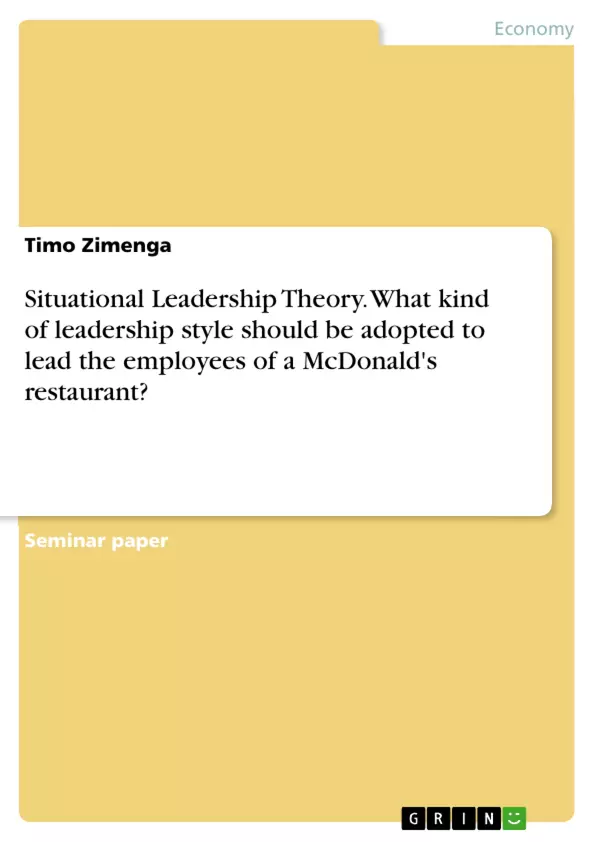Due to the increasing democratic development, it is on the one hand much harder to find employees in the labor market and on the other hand, the employees who already work in the company must be kept. Therefore, care should be taken to keep the existing staff well organized and well led so that tasks can be done efficiently and effectively. In order to be able to lead employees well, however, it is necessary to know the level of development at which these employees are located, since not everyone can handle every task.
In order to find out more regarding leading different people, this assignment deals with the following research question: “Based on Situational Leadership Theory: what kind of leadership style should be adopted to lead the employees of a McDonald's restaurant?”
Firstly, this paper will provide a short introduction about the theoretical background, namely Situational Leadership Theory. Within this, two main tools are introduced:
1. the employees’ readiness to fulfill a task
2. the level of development which describes the motivation and willingness of each employee.
This insight is needed to finalize the appropriate leading style in the end. After a short introduction of the McDonald’s Company, the theoretical aspects of the Situational Leadership Theory will be transmitted towards it, to get a deeper impression regarding this approach. As a result, a percentage distribution of the different lengths of employment is presented before combining and analyzing these findings with the gained knowledge from the theoretical background. Finally, a conclusion as well as a critical view of the theoretical background and the practical implementation are provided and additionally, some recommendations on how to deal with employees in a different stage are given.
Inhaltsverzeichnis (Table of Contents)
- Executive Summary
- List of Abbreviations
- List of Figures
- Introduction
- Way to Situational Leadership Theory
- Situational Leadership Theory
- Level of development
- Leading orientation in business environment
- Transition
- Case: McDonald's Company
- Conclusion
- Bibliography
- ITM Checklist
Zielsetzung und Themenschwerpunkte (Objectives and Key Themes)
The objective of this paper is to examine the application of Situational Leadership Theory (SLT) in leading employees at a McDonald's restaurant. By exploring the connection between employee development levels and appropriate leadership styles, this work aims to offer practical guidance for managing employees in a fast-food setting.
- Situational Leadership Theory
- Employee readiness and development levels
- Leadership styles and their application in various contexts
- The specific challenges of leading employees in a McDonald's environment
- Practical implications and recommendations for effective leadership
Zusammenfassung der Kapitel (Chapter Summaries)
The introduction provides a background on Situational Leadership Theory and its key components, including employee readiness and development levels. It establishes the relevance of this theory for managing employees, particularly in a fast-paced environment like a McDonald's restaurant.
The second chapter delves into the application of Situational Leadership Theory in the context of a McDonald's restaurant. It analyzes the company's structure and employee profile, utilizing data on employee tenure to gain insights into their development levels. The chapter further explores how different leadership styles can be applied to effectively manage employees at various stages of their development.
Schlüsselwörter (Keywords)
This paper focuses on Situational Leadership Theory (SLT), employee development, leadership styles, fast food environment, McDonald's, and practical application of leadership principles.
- Arbeit zitieren
- Timo Zimenga (Autor:in), 2018, Situational Leadership Theory. What kind of leadership style should be adopted to lead the employees of a McDonald's restaurant?, München, GRIN Verlag, https://www.grin.com/document/920737



